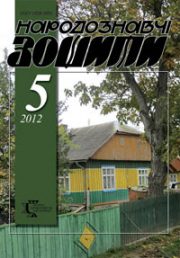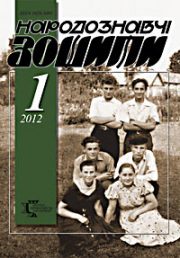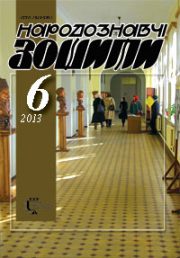The Ethnology Notebooks. 2025. № 5 (185), 1180—1187
UDK7.012:7.046(=161.2)
DOI https://doi.org/10.15407/
ETHNOCULTURAL HERITAGE AS A SOURCE OF FORMATION IN CONTEMPORARY DESIGN
VASKEVICH Olga
- ORCID ID: https://orcid.org/0000-0002-1936-7342
- PhD in Vocational education, Acting Head of the Department
- of Monumental and Easel Painting, Mykhailo Boichuk Kyiv
- State Academy of Decorative Applied Arts and Design,
- Contacts: 32, M. Boychuk St., 01103, Kyiv, Ukraine
Abstract. The article examines the role of ethnocultural heritage in contemporary design as an important resource for preserving national identity and developing new approaches in project-based thinking. In the context of globalization and the unification of visual space, the need arises to employ traditional ornamental motifs, constructive principles, and color schemes not only as decorative resources but also as a conceptual foundation for design practices.
The relevance of the topic is determined by the necessity to find ways to harmoniously combine traditional artistic codes with modern creative industries, which allows preserving cultural authenticity while simultaneously integrating into the global cultural space. Special attention is given to the issue of maintaining national identity in design, developing educational practices, territorial branding, and creating sustainable and socially responsible visual solutions.
The aim of the study is to analyze the ways of integrating folk artistic traditions into graphic, product, textile, and spatial design, as well as to identify their influence on the formation of a new ideology of project-based thinking.
Methods of cultural studies, art history, and comparative-analytical analysis made it possible to trace the interconnections between traditional cultural heritage and contemporary design practices, and to determine the semantic, compositional, and technological aspects of integrating ethnocultural codes into design.
The results of the study indicate that ethnocultural heritage serves not only as a source of stylistic inspiration but also as a foundation for creating sustainable, ecological, culturally relevant, and socially significant solutions. It is shown that ethnodesign acts as an effective means of dialogue between the past and the present, contributes to the preservation of crafts, generates new economic opportunities for local communities, and fosters a positive national image in the global context. The necessity of an interdisciplinary approach to understanding ethnocultural heritage as a dynamic resource capable of combining aesthetics, functionality, and the value orientations of society is emphasized.
Keywords: ethno-design, folk art, form creation, Ukrainian visual culture, decorative and applied art, design engineering, tradition, ornament.
Received 30.08.2025
REFERENCES
- Antonovych, Y. (2015). Ethnorenessances in 20th-century culture and their ethnodesign dimensions. Ethnodesign: European vector of development and national context: Collected scientific papers (Book 1, pp. 7—11). Poltava: PNPU [in Ukrainian].
- Afanasyev, Y. (2011). Ethnostyle in the context of ethnocultural, national, and globalization paradigms. Art Studies Notes: Collected Scientific Papers, 19, 197—202. Kyiv: Millenium [in Ukrainian].
- Brovchenko, A.I. (2011). Formation of professional competence in the basics of ethnodesign for future labor education teachers: Abstract of dissertation for the degree of Candidate of Pedagogical Sciences (specialty 13.00.02 — Theory and Methods of Labor Training). Kyiv [in Ukrainian].
- Shpak, O.V. (2023). Training future bachelors of graphic design to use calligraphy in professional activity: Doctor of Philosophy dissertation (015.01) — Kyiv State Academy of Decorative and Applied Arts and Design named after Mykhailo Boychuk. Kyiv [in Ukrainian].
- Kolesnikova, A., Podlevskyi, S., & Osadcha, A. (2025). Ethnodesign in the context of digital technologies: Computer graphics in creating visual identity. Actual Issues of Humanities, 83 (2), 50—57 [in Ukrainian].
- Kolesnikova, A., & Tymenko, V. (2024). From tradition to innovation: Integration of ethnodesign in graphic design in the process of gifted students’ assessment. Giftedness: Methods of diagnostics and ways of development. Proceedings of the Scientific-Practical Online Seminar (Kyiv, May 23—26, 2024) (Pp. 276—279). Kyiv [in Ukrainian].
- Petrova, I.V., Ryzhyi, M., & Vaskevych, O.Y. (2024). Using elements of Bubniv painting in modern graphic design: Case study of the corporate style of the Creative-Experimental Laboratory «KERAMMISTO». Modern Art Practices: Traditions, Innovations, Prospects. Collection of abstracts and reports from the All-Ukrainian Scientific-Practical Conference of Researchers and Young Scientists (April 25, 2024) (Pp. 134—140) [in Ukrainian].
- Sivash, I.O. (2018). Ethnodesign as a component of forming scientific ideas about the Ukrainian national style at the beginning of the 20th century. Bulletin of NAKKKiM: Scientific Journal, 2, 319—323. Kyiv: Millenium [in Ukrainian].
- Yurchenko, I.A. (2014). Special approaches and methods of creating design objects based on ethnocultural traditions. Bulletin of Kharkiv State Academy of Design and Arts: Collection of Scientific Works (Pp. 42—47). Kharkiv: KhDADM [in Ukrainian].







